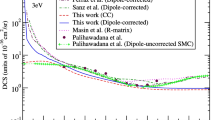Abstract—Changes in the level of DNA damage induced by atmospheric factors were evaluated from the percentage of tail DNA (%TDNA) in the comet assay of mouse cells for blood leukocytes, Ehrlich ascites carcinoma, and P388 lymphocytic leukemia. It was shown that (1) the values of DNA damage of blood leukocytes (%TDNA) were high within narrow ranges of atmospheric temperature (from –4°С to +3°С) and atmospheric partial oxygen contents within 298–304 mg/L; (2) the range of variations in %TDNA of leukocytes increased with increasing geomagnetic activity; (3) the changes in %TDNA of intact and X-irradiated (4 Gy) leukocytes and of tumor cells were associated with changes in air temperature; and (4) %TDNA correlated with atmospheric temperature in both types of intact tumor cells and irradiated P388 cells. Thus, variations in %TDNA appear to be caused by reactive oxygen species generated in the environment at temperatures of phase transitions of water. It is conceivable that changes in the basal %TDNA of cells modulate their radiation response.








Similar content being viewed by others
REFERENCES
T. A. Zenchenko, Doctoral Dissertation in Biology (Pushchino, 2016).
T. A. Zenchenko, A. N. Skavulyak, N. I. Khorseva, et al., Geofiz. Protsessy Biosfera 12 (1), 22 (2013).
T. A. Zenchenko and N. G. Varlamova, Geofiz. Protsessy Biosfera 14 (2), 50 (2015).
A. L. Markov, T. A. Zenchenko, Yu. G. Solonin, et al., Aviakosm. Ekol. Med. 47 (2), 29 (2013).
A. I. Gaziev, Radiats. Biol. Radioekol. 39 (6), 630 (1999).
E. I. Azzam, J. P. Jay-Gerin, and D. Pain, Cancer Lett. 327, 48 (2012).
A. R. Collins, A. A. Oscoz, G. Brunborg, et al., Mutagenesis 23 (3), 143 (2008).
D. A. Moshkov, S. P. Romanchenko, E. Yu. Parnyshkova, et al., Bull. Exp. Biol. Med. 154 (5), 686 (2012).
E. V. Inzhevatkin, Practical Course in Experimental Oncology: Ehrlich Ascites Carcinoma (Krasnoyarsk State Univ., Ktasnoyarsk, 2004) [in Russian].
N. K. Chemeris, A. B. Gapeyev, N. P. Sirota, et al., Mutat. Res. 558, 27 (2004).
D. P. Lovell and T. Omori, Mutagenesis 23 (3), 171 (2008).
P. M. Nagorskii, T. A. Zenchenko, K. N. Pustovalov, et al., Vestn. KRAUNTs: Fiz.-Mat. Nauki 4 (20), 64 (2017).
N. Sirota, E. Kuznetsova, and I. Mitroshina, Radiat. Environ. Biophys. 57 (2) 115 (2018).
G. A. Domrachev, D. A. Selianovskii, P. A. Stunzhas, et al., Preprint No. 537, IPF RAN (Institute of Applied Physics, Russian Academy of Sciences, Nizhny Novgorod, 2000). http://mognovse.ru/nzx-effektivnoste-obrazovaniyaperoksida-vodoroda-i-radikalov.html; http://pandia.ru/text/80/052/50489.php
M. V. M. Lafleur, J. Woldhuis, and H. Loman, Int. J. Radiat. Biol. 39 (2), 113 (1981).
M. V. M. Lafleur, J. Woldhuis, and H. Loman, Nucleic Acids Res. 9 (23), 6591 (1981).
G. Speit, K. Trenz, et al., Toxicol. Lett. 110, 73 (1999).
E. S. Menchinskaya, Candidate’s Dissertation in Biology (Vladivostok, 2014).
http://www.bionco.ru/methods/exp_chemotherapy/ strains/char_strains/P388.
Models and Methods of Experiemental Oncology, Ed. by A. D. Timofeevskii (Medgz, Moscow, 1960) [in Russian]. http://wincancer.ru/onkologiya/strana.html.
L. A. Suvorova and L. Yu. Nugis, Med. Radiol. Radiats. Besopasn. 57 (1), 30 (2012).
ACKNOWLEDGMENTS
We are grateful to A.I. Gaziev, I.Yu. Mitroshina, and M.G. Lomaeva for assistance in some experiments. We appreciate the donation of Ehrlich carcinoma cells by S.P. Romanchenko (Laboratory of Cell Engineering, ITEB, Head of the Group of Cytogenetic Studies S.I. Zaichkina) and the donation of the inoculum of lymphocytic mouse leukemia P388 cells by V.V. Shaposhnikova (Laboratory of Oxidative Stress, ITEB, headed by Yu.N. Korystov).
Funding
This work was supported in part by the Russian Foundation for Basic Research, project 17-29-01007_ofi_m.
Author information
Authors and Affiliations
Corresponding author
Ethics declarations
Conflict of interest. The authors declare that they have no conflict of interest.
Statement on the welfare of animals. All applicable international, national, and/or institutional guidelines for the care and use of animals were followed. Animals were treated as recommended by the Biosafety and Bioethics Committee, ITEB.
Additional information
Translated by Victor Gulevich
Abbreviations: ROS, reactive oxygen species, EAC, Ehrlich ascites carcinoma, GA, geomagnetic activity.
Rights and permissions
About this article
Cite this article
Kuznetsova, E.A., Sirota, N.P. & Zenchenko, T.A. Changes in the Level of DNA Damage in Mouse Cells Induced by Atmospheric Factors. BIOPHYSICS 64, 349–357 (2019). https://doi.org/10.1134/S0006350919030114
Received:
Revised:
Accepted:
Published:
Issue Date:
DOI: https://doi.org/10.1134/S0006350919030114




